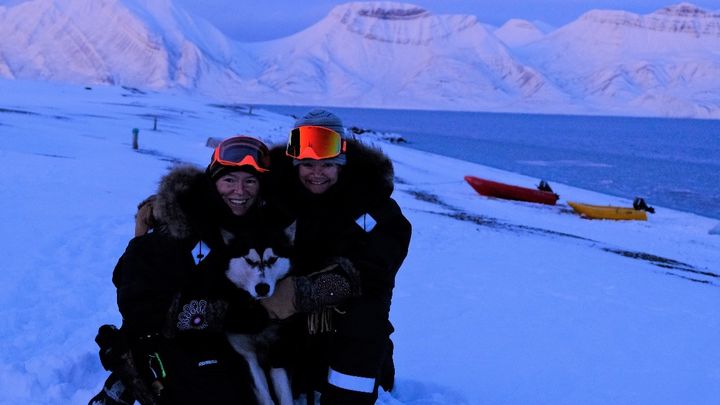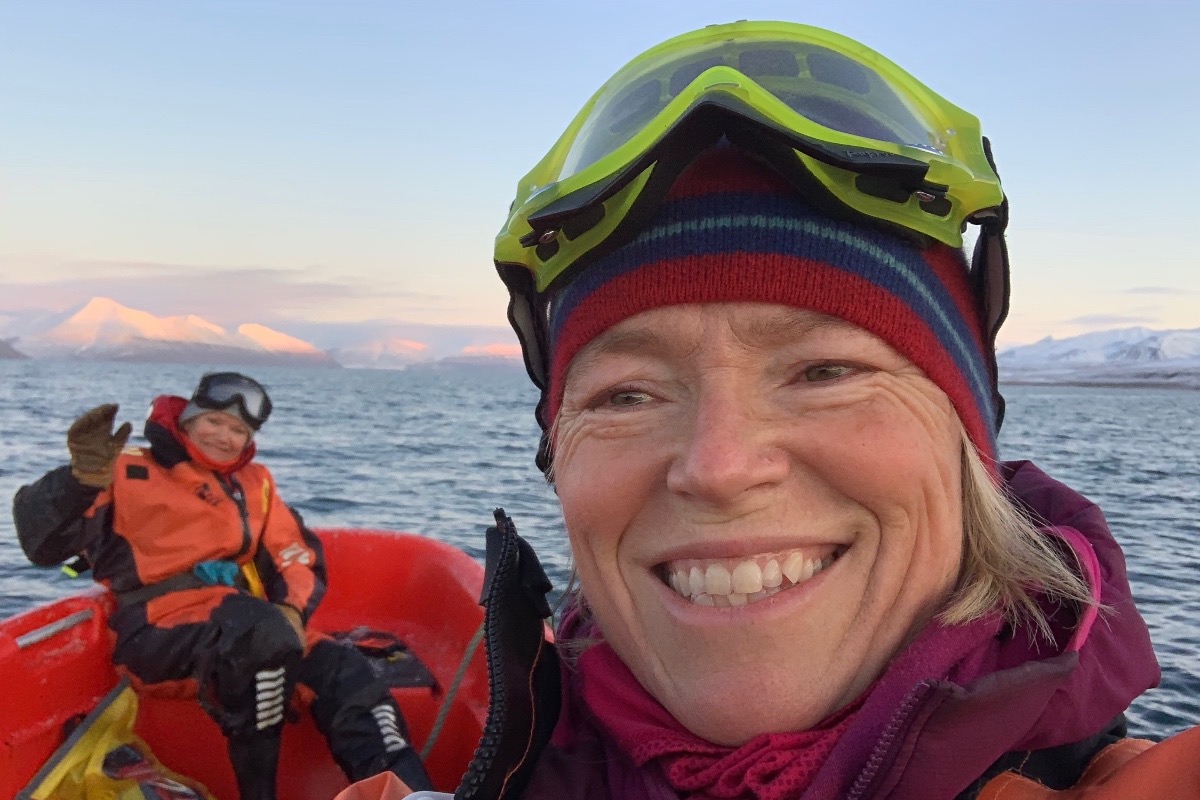
Hearts in the Ice - Embrace the Planet Project
Welcome to Hearts in the Ice - Embrace the Planet Project
The project “Hearts in the Ice” was created to raise awareness and inspire dialogue about climate change in our polar regions and the worlds in between.
All donations go directly to support the efforts and platform of team Hearts in the Ice - Sunniva Sorby and Hilde Fålun Strøm - as they continue their work from the very remote isolated trappers cabin called “Bamsebu” which means “LittleBear Hut”.
Be sure to watch this video teaser from the Hearts in the Ice documentary, by Halvor Mykleby. 
Hilde and Sunniva are using their time at “Bamsebu" - located 140 km away from the nearest neighbor - to contribute as citizen scientists to projects with organizations around the world. Their mission is to engage and educate youth and adults through social media feeds and weekly blog posts found on the Hearts in the Ice website.
Support is needed for continued communication through satellite equipment and continued outreach and social media engagement.
Please note that the currency for this GoFundMe page is Norwegian Kroner (NOK). For instance, a donation of 20 NOK = approximately 2 USD, and 200 NOK = approximately 20 USD and so on.
For every donation between 200-800 NOK = $20-80 USD you will have our endless gratitude and we will thank you on social media!
For every donation over 2000 NOK= $200 USD - you will get a personal thank you from Sunniva and Hilde from the Arctic and we will shout out our thanks and you’ll be listed on our website!
Alternatively, you can support us by purchasing an official Hearts in the Ice pendant , which will make you an official member of this Global Movement. You can purchase the pendant by clicking here .
Put your Heart into Embracing the Planet- with an official Hearts in the Ice pendant!
This universal symbol of protecting and embracing our planet, its creatures and resources is made from handmade glass with a “Heart in the Ice” or “Heart in the Ocean Blue”.
Read why other women want to support the project by wearing the Hearts in the Ice necklace: Why we wear the Hearts In The Ice necklace .
Designed by world renowned Norwegian artist Ellen Kvam, each pendant is unique. For anyone interested in selling Hearts in the Ice pendants in quantities please contact: [email redacted] for details.
For anyone interested in selling Hearts in the Ice pendants in quantities please contact: [email redacted] for details.
You can also support us by purchasing a Hearts in the Ice bookmark, created with an Ellen Kvam glass square with a sparkling heart - a Heart In The Ice. You can purchase the official Hearts in the Ice bookmark by clicking here .
For business owners, this is a perfect Christmas gift with a meaning for your employees. Orders of 100 bookmarks or more can be custom made to include your business logo at the back of the bookmark. If you would be interested in this, please contact [email redacted].
Join our Global Movement!
Why are they staying longer than the planned 9 months at Bamsebu?
With crisis comes the opportunity for change, and even though it seems difficult now, we all need to look at what values we want to take with us further.
In a world where we have had troubles slowing down our consumption or been unwilling to take the necessary steps to reach the 1.5-degree global temperature target, the coronavirus has put up a very clear STOP sign up for us.
The 9-month over-wintering for Hearts in the Ice changed gears with the news of COVID-19.
The planned pickup was scheduled for May 8th, 2020. The 100-passenger ship that was due to pick us up was cancelled because of global travel restrictions and to maintain the safety of all invited guests. During Hilde and Sunniva's Zoom chat with the guests that should've been on board, Joss Stone and Celine Dos Santos played this beautiful song - video by Joss and Celine in “ New Born” .
Hearts in the Ice will continue working from Bamsebu until at least September 2020.
We are continuing our self-imposed isolation to speak to the power of connectivity between all people and our natural world.
There has been much International press generated for Hearts in the Ice, which helps to elevate our platform - Hearts in the Ice - but we need financial support to continue our work as it is a labor of love for our natural world.
Education
From our tiny trapper's hut we have connected with over 5,000 youth from around the world on topics like Technology/Innovation, Food/Culture, our Oceans, Climate Change, Biodiversity, Wildlife and Weather. All these events were hosted via Zoom video between September 2019 and May 2020, and featured experts on each topic.
We have also reached many thousands with live YouTube links. See the library here .
We will continue to host monthly calls from May 2020 until September 2020 to engage youth and adults through Exploring by the Seat of Your Pants . 
Citizen Science Projects
Hearts in the Ice will continue to serve as citizen scientists by collecting data and observations throughout the summer for the following projects:
· Visible and thermal drone data with the British Columbia Institute of Technology (BCIT)
· Microscopic marine life observations with the Scripps Institution of Oceanography
· Species observations with the University Centre in Svalbard
· Cloud observations with NASA’s GLOBE Observer
· Sea ice and species observations with the Norwegian Polar Institute
· Collecting plastic waste from the Ocean and shoreline
What is Citizen Science and why does it matter?
“During several decades, the overall trust in science has declined globally,” says Borge Damsgard, acting director and department head of Arctic biology at the University Centre in Svalbard. He is one of the lead science contacts for Hearts in the Ice.
Citizen science is a term given to any project that involves public collaboration in contribution to scientific research. The goal is to engage the public and use the data collected to increase overall knowledge on a given subject.
Citizen science has the power to transform science and society. We live in a time where technology and information and collaborate on research that can help us all better understand the impact our changing climate is having on our wildlife, micro-organisms in the water, air, and ice, weather systems and cultures and peoples around the world.
"One of the challenges is that people find it difficult to connect to big-picture global data", Damsgard adds. “Citizen science is a way to close the gap between people’s perception and scientists monitoring the climate changes.” The 20 sq mtrs Trappers cabin called " Bamsebu", home for Hilde and Sunniva for the year.
The 20 sq mtrs Trappers cabin called " Bamsebu", home for Hilde and Sunniva for the year.
What have Sunniva and Hilde been doing isolated and so far away from civilization for a year in the Arctic and why?
We are leaders on the front lines and understand that we have powerful voices through which to share our findings with others. As two women who have spent decades exploring and working in the Polar Regions we felt that we could add value to our understanding of climate change.
We could also test the limits of our skills and abilities by over-wintering (spending 3 months in complete darkness), collaborating with scientists (engaged in 7 citizen science projects), and being keen observers of wildlife (from Polar bears to belugas) to the changes up here in the Arctic over 9 months.
The power of nature- it’s subtle sounds and how it all spins a story around the cycles of a season. We have developed a keen understanding around what we see. Changes that happen are a result of adaptation. For example, polar bear hunting reindeer is not usual behaviour, yet it has happened! These stories help us to understand the bigger picture and these stories connect us all in this conversation around climate change.
Our simple efficiency of living so closely to nature amplifies our thoughts, affects our daily choices and illuminates the challenges we all face as a species. We want to continue to help people around the world understand how important they are and how important their choices are – every action creates a chain reaction.
What can you do to engage and make a difference?
Anything that involves getting outside and observing nature can be turned into a citizen science project. All you need is a place, a question (what do you want to learn/observe?) and a desire to explore. There are endless opportunities for teachers to get their students involved, so here are some ideas for getting started:
· Consider getting involved with one of the citizen science projects mentioned above, such as NASA’s GLOBE Observer or the polar phytoplankton FjordPhyto project .
· We encourage you to download Canadian Geographic Education’s Fieldwork Guide and lesson plan about Canada’s Great Trail .
· Participate in a BioBlitz in your community to learn about native plants and animals as well as invasive species in your local area. You can also take photos of different species and tag their locations using free apps like iNaturalist to contribute to a global database and connect with nature enthusiasts and researchers around the world.
· Arrange for a garbage clean up at a local park or conservation area. Use the Litterati app to collect data on where the waste is found and what types are most common.
· Look for more citizen science projects near you at SciStarter , a catalogue of more than 3000 active projects globally!
Connecting with Hearts in the Ice
· Signup for weekly blog updates at Hearts in the Ice
· Pre- purchase a copy of our book at our shop (due for release in Nov 2020)
· Donate to this GoFundMe campaign or purchase the Hearts in the Ice pendant as an official symbol of change and action
· Consider becoming a sponsor for Hearts in the Ice by emailing [email redacted]
Follow us on Facebook and Instagram (use hashtags #bamsebu and #heartsintheice)